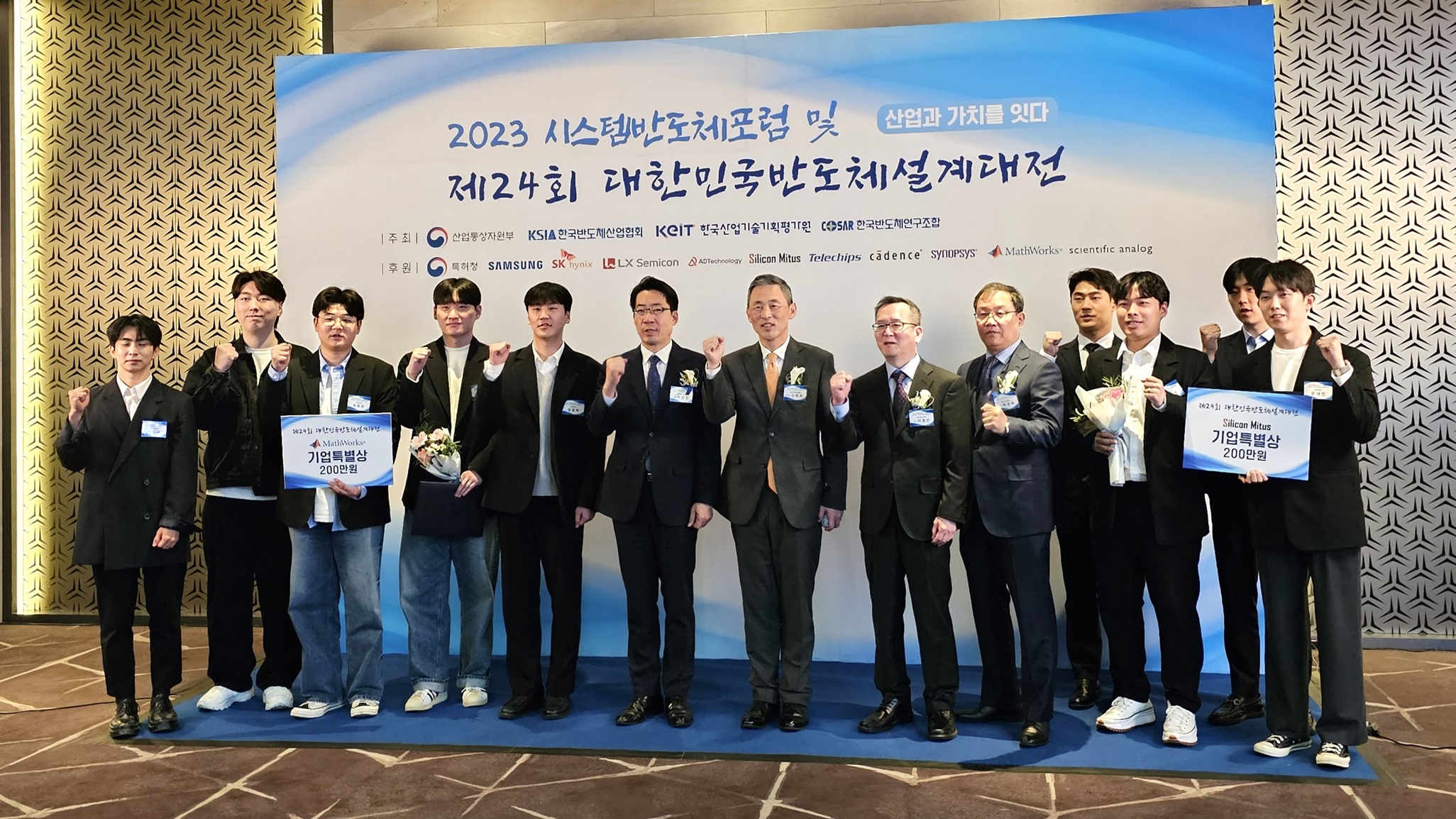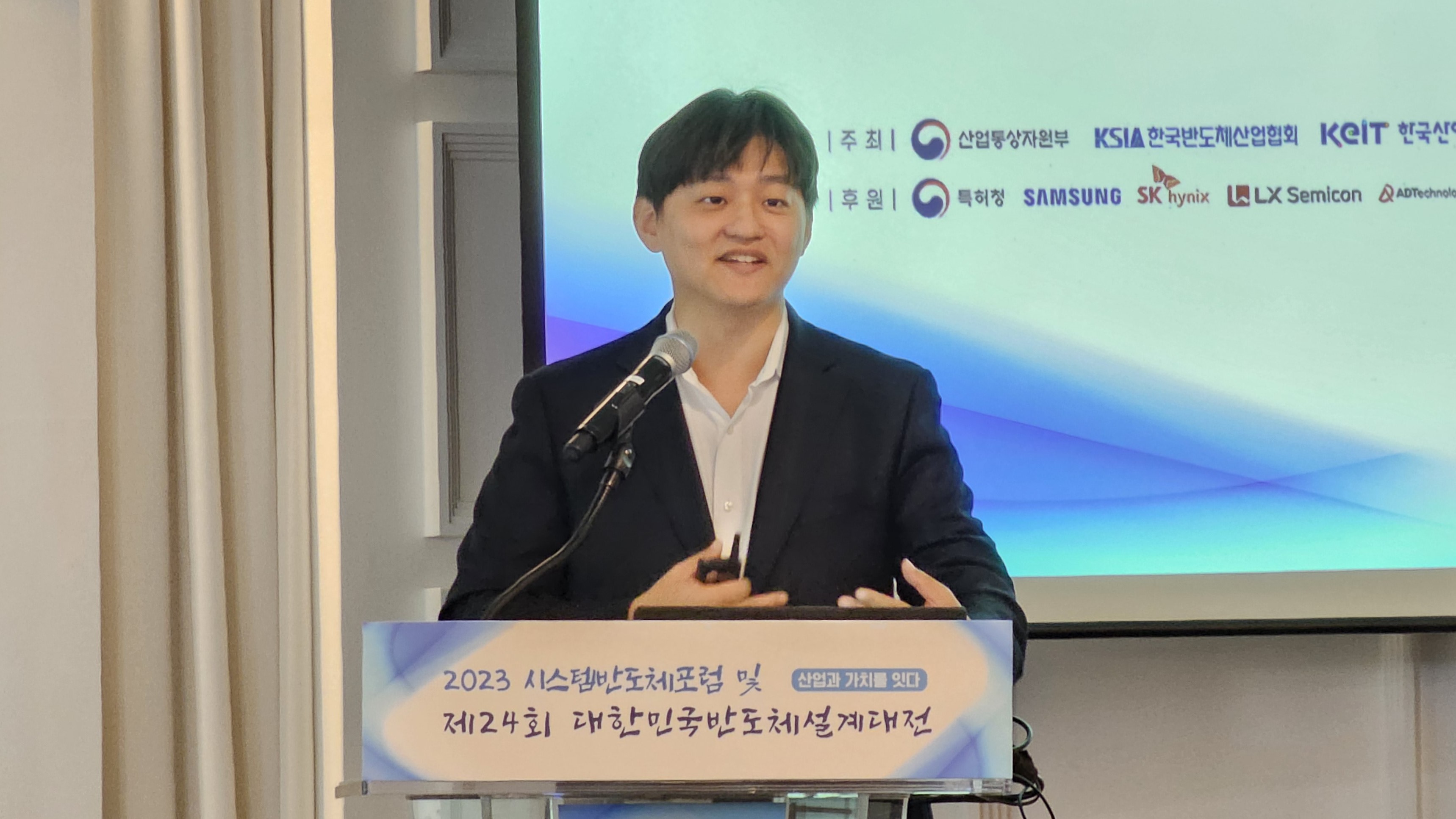AI가 이끄는 반도체 수요 회복이 가시화되고 있다. 2024년 전망이 업황 회복과 턴어라운드를 보일 것으로 점쳐지는 가운데 가동률 속도조절이 내년의 최대 화두가 될 전망이다.

▲2023 시스템반도체포럼에서 제24회 대한민국 반도체설계대전 수상자들과 김정회 한국반도체산업협회 부회장(중앙 우측), 이용필 산업통상자원부 국장(중앙 좌측)이 함께 기념사진을 찍고 있는 모습.
AI 서비스 고도화 성패, 반도체 시장 좌우
AI PC·AI 모바일 신규·조기교체 수요 자극
“공급社 욕심 조절 必, 가동률 속도 조절”
AI가 이끄는 반도체 수요 회복이 가시화되고 있다. 2024년 전망이 업황 회복과 턴어라운드를 보일 것으로 점쳐지는 가운데 가동률 속도조절이 내년의 최대 화두가 될 전망이다.
2023 시스템반도체포럼 및 제24회 대한민국 반도체설계대전이 한국반도체산업협회 주관으로 7일 서울 삼성동 소노펠리체컨벤션에서 개최했다.
시스템반도체 분야 주요 기업의 기술 트렌드를 공유하고, 미래 신산업 유망기술 정보를 제공하기 위한 이번 포럼은 반도체 설계대전 시상식을 시작으로 △24년도 세계 경제 전망 △초거대 AI믿:음 and AI반도체 △자율주행차의 개발현황과 전망 △AI클라우드센터 구축과 AI가속기 선정 △파운드리 기술트렌드 및 생태계 강화방안 △24년도 시스템반도체 R&D 기획방향 등의 세션이 발표됐다.
이날 반도체 시장 경기 전망에 대해 삼성증권 이종욱 수석연구원이 발표했다. 현 반도체 시황이 회복세를 가져갈 것으로 점쳐지는 가운데 인공지능(AI)이 이끄는 모멘텀이 강하게 2024년을 이끌 것으로 기대되고 있다.

▲삼성증권 이종욱 수석연구원
이종욱 연구원은 “생성형 AI를 비롯한 AI 서비스 검증이 향후 반도체에 굉장히 중요하다”며 AI 서비스의 흥행은 곧 하이퍼 테크 기업들의 AI 서버 및 일반 서버 확충 등의 수요를 강하게 일으킬 것으로 내다봤다.
일반 서버의 투자 증가는 올해 저조했던 반면 내년 서버 수요는 10%대 증가를 보일 것으로 기대되고 있는데 AI 흥행이 이러한 서버 및 AI 서버 투자를 경쟁적으로 강화시킬 수 있을 것으로 풀이된다.
또한 레거시 영역인 PC 및 모바일 디바이스에서의 수요가 그간 좋지 않았다는 점이 반도체 업황을 낙관적으로만 볼 수 없었던 리스크 중 하나였다. 이러한 모바일 및 PC 시장은 메모리 영역에서 50%와 15%를 각각 차지하는데 AI 반도체 시장은 현 시점 메모리 영역의 4~5%, 시스템반도체 5~6% 정도에 불과했다.
이에 모바일 시장에서의 회복이 필요한 상황이며, 향후 AI 서비스 고도화 성패뿐 아니라 AI PC 등장과 AI 탑재 디바이스의 증가는 신규 수요 및 조기 교체 수요 등을 발생시켜 반도체 시장 확대에 시너지 효과를 낼 수 있을 것으로 업계는 기대하고 있었다.
모바일 수요 증가가 기대되는 움직임으로 중국 시장에서 화웨이를 중심으로 프리미엄 스마트폰뿐 아니라 중저가 스마트폰에서의 반도체 부품 주문이 증가하고 있다. 화웨이가 부품 수급을 확대하자 오포, 비보 등도 경쟁적으로 부품 확보에 나서는 것으로 전해지며, 애플도 아이폰의 부품 주문을 줄이지 않는 것으로 전해졌다.
이 연구원은 “스마트폰 부품은 내년 설연휴까지는 호황일 것이며, 스마트폰 제품은 판매가 잇따라 증가하진 않을지 몰라도 2024년 1분기까지는 반도체 수요 좋다”고 언급했다. 다만 1분기 이후로는 추세 전망이 불투명하다고 덧붙였다.
2024년 가장 큰 화두는 반도체 가동률 회복에 있다. 수요 침체로 현재 파운드리 및 메모리 가동률이 많이 떨어진 상태인데 가동률 회복의 속도 조절이 중요할 전망이다. 이 연구원은 “케파 확대는 결정하기 어려운 반면 가동률은 결정하기 쉬워 수급은 어떻게 될지 변수가 된다”며 “공급업체들의 욕심 조절이 내년도 수급의 큰 화두가 될 것”이라고 전망했다.

▲김정회 한국반도체산업협회 부회장이 개회사를 하고 있는 모습.
김정회 한국반도체산업협회 부회장은 “지난해 메모리 업계가 어려웠을 때 시스템반도체는 상대적으로 영향이 적었으며, 메모리와 시스템반도체 업계를 균형되게 가져가는 것이 좋다는 것을 깨닫는 계기였다”며 “시스템반도체에 가장 중요한 것은 고급인력과 설계인력 양성에 있다”고 말했다.
이용필 산업통상자원부 국장은 “반도체 산업은 우리 경제 핵심으로 수출의 19% 담당하며, 전체 제조업 생산의 8%를 차지한다”고 강조하며 “팹리스 및 디자인하우스, 파운드리 등 시스템반도체 분야에서 열세를 극복하고 글로벌 경쟁력 확보해야 하는 상황이다”라고 언급했다.
이에 “현재 정부는 기업과 인재가 이끄는 반도체 초강국 달성에 노력하고 있으며, 반도체 아카데미 신설, 국책 R&D 추진, 생태계 조성 위한 특화단지 지정 및 육성에 지속 노력하겠다”고 밝혔다.


